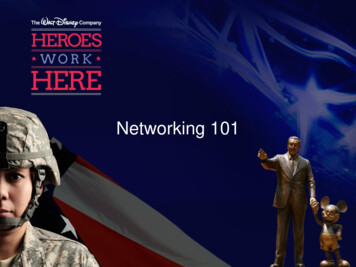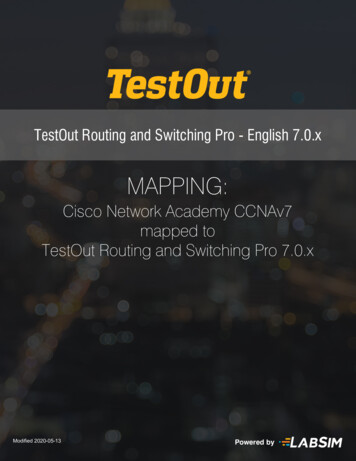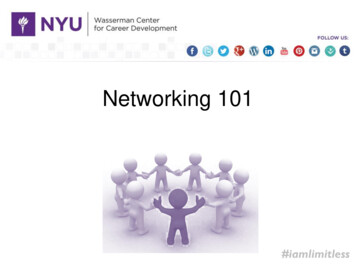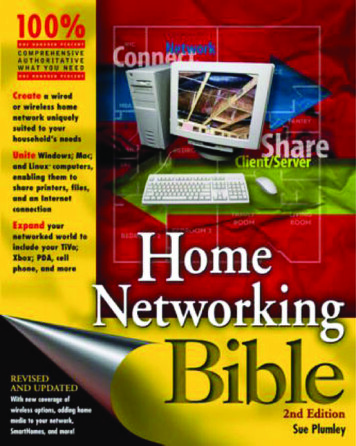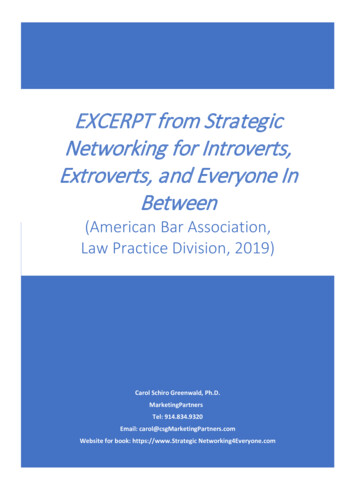
Transcription
EXCERPT from StrategicNetworking for Introverts,Extroverts, and Everyone InBetween(American Bar Association,Law Practice Division, 2019)Carol Schiro Greenwald, Ph.D.MarketingPartnersTel: 914.834.9320Email: carol@csgMarketingPartners.comWebsite for book: https://www.Strategic Networking4Everyone.com
IntroductionI am not a natural networker; I am an introvert who networks. I work in anindustry where, in order to succeed, I need to interact with a wide group of people,some of whom I know well and many I don’t know at all. I learned to networksuccessfully by creating a comfortable process for myself. Usually, when I joingroups I get involved on committees, often ending up as a member of the boardor president. Having a role helps me feel useful and comfortable in the group. Ifyou ever see me at a large group function, probably I am one of the speakers.Again, a role that keeps me grounded and calm.I’ve made a good living coaching lawyers and other professionals in practicalskills, including leadership, management, business development, and networking. Being an intellectual introvert has helped me communicate with otherintellectual introverts. I share the lessons I’ve learned. I teach my clients how toresearch and plan, how to create “safe havens” from which to venture forth andexplain the why of what they do. Practicing what I preach has enabled me toparticipate in many wonderful group encounters, lead important and interestingorganizations and projects, and keep my own company’s pipeline filled withstimulating, remunerative work.I wrote this book for all the “nonnaturals” in the world who are afraid of thenetworking process. The book offers anyone who takes the time to read it thetools to turn ad hoc networking into a series of planned strategic steps that willmove them toward their goals. The security of a plan and preparation offersintroverts the confidence they need to venture forth. The book is also for all thehyper-extroverts who sail through an event having too much fun to maximize theavailable networking opportunities. Strategic networking keeps extrovertsfocused; helps introverts feel safe; and encourages everyone to make efficient,effective use of their networking time. . .Strategic NetworkingExplained1Networking is more than a marketing technique. It is a way to build your service orbusiness by engaging in activities that are natural to humans. We are mentallyprogrammed to connect with other people, help them thrive, and, in helping others,flourish as well. The best networkers create these positive associations. They want tounderstand the needs of others and help them move forward. As they gain reputationsfor helping others succeed, they too grow.This kind of networking is positive. It creates affirmative feelings of support,understanding, and trust between the giver and the given. It is strategic because it is
goal driven. In this book we look at the why, what, and how of networking: Why it is possible to do well by doing good.What strategic networking is.How to proceed in the most effective way.On the one hand, data show “that more than 80 percent of professionals con- sidernetworking to be crucial to their success.”1 On the other hand, data show that “one infour don’t network at all.”2 This book is for people in both camps: those who knowthey should but don’t, and those who do but not as successfully as they would like.To get a clearer sense of how master networkers approach networking, Iinterviewed 35 of them from a variety of industries and professions. When you askthese networking pros to explain why networking is important to them, the sameconcepts recur over and over. They emphasize the feel-good aspects: Meeting people, interesting people, people with similar values andinterestsBuilding relationshipsHelping others and, in turn, being helped by othersExpanding their horizonsBeing a connectorBeing visible to those who are important to themBecoming part of a communityFollowing conversations of interestSharing their expertiseFor these professionals, effective networking is an important component of theirsuccess. Their investments in networking activities have enabled them to becomerainmakers, build successful relationships, and enjoy reputations as effectiveconnectors.David Maister, a prominent law practice pioneer and consultant to professionals, wrote that to be successful in life one should “spend your investment timeas seriously as income time. . . If your investment time is spent wisely on carefullychosen activities, you will have the ability to significantly affect your futuresuccess—and lifestyle.”31.Email invitation from Network After Work—Seattle, April 16, 2018, info@networkafter work.com.2. Aja Frost, “15 Surprising Stats on Networking and Face-To-Face Communication,” updated November 15, etworking-stats.3. David H. Maister, True Professionalism (Simon & Schuster, 1997), p. 48.
Both Taylors attend the same Attain Success Group cocktail party. Taylor Together arrives early to work the room. S/he has done some research aboutthe event and attendees and has a mental list of people to meet, those s/he wantsto reconnect with and what s/he might add to conversations. Taylor Together looksattractively professional and is obviously in an outgoing, good mood as reflectedin her/his body language. Taylor Timid enters late, grabs a cup of coffee, and exchanges cards with somepeople in the coffee line. S/he looks disheveled, grumpy and a bit out of sorts. Taylor sits down at a table and pulls out her/his phone to check for any messages. Afew people drifting by say hello. Taylor Timid wonders why s/he decided to attendthis meeting in the first place.Back in the office, Taylor Together spends 15 minutes updating his/her contact list andmaking plans to keep in touch with two people s/he met who could, over time, becomeclients. S/he thought to her/himself, what a useful, engaging event. Taylor Timid leavesfeeling s/he has wasted an evening on a boring event with uninteresting people of noparticular value to her/his practice. S/he takes 15 business cards out of a jacket pocketand throws them in the circular file.The moral of this tale is that networking is what you make it. With some preparationand a forward-thinking attitude about the event, Taylor Together’s evening led to twonew connections and interesting conversations. Taylor Timid had a handful of business cards from strangers to add to her/his email list. When networking is an ad hoc,thrown-together, last-minute activity, as it was for Taylor Timid, it is rarely worth morethan the effort put into it.Now, let’s look at how it plays out in real life by sketching the activities of twowomen, one a lawyer and the other a financial planner, both of whom buildbusinesses, resources, and friendships through strategic networking.Abby Rosmarin, Lawyer, Mediator,Mental Health CounselorAbby Rosmarin is a lawyer, mediator, conflict coach, NYS Licensed Mental HealthCounselor, and executive director of the New York Association of CollaborativeProfessionals. She thinks of the word “networking” as negative because in her mindit is linked to “aggressive salesmanship.” Yet, she is an experienced, effectivenetworker who has built her practice through networking. She networks to learn, tomentor, and to help others. For her, “networking is about learning from colleagues,sharing common interests and seeking opportunities for experiences with like-mindedpeople.” She doesn’t believe in speed networking, business card exchanges, or oneminute intros.
4Strategic Networking for Introverts, Extroverts, and Everyone in BetweenAbby thinks that typical networking activities elicit surface knowledge ofother people. She wants an in-depth interpersonal connection so that she feels shereally knows which individual in her network can best help each client. Abbybroadens her network by using social media to connect to people she reads about,and then typically arranges to meet them in person to get to know the actualperson. Her LinkedIn groups similarly reflect the therapist lens through which shedefines meaningful r e l a t i o n s h i p s .Her networking is guided by her interests and beliefs. She follows her inclinations—she has studied a range of topics from other fields, such as medical bioethics, to enhance her interdisciplinary collaboration with others and expand herability to help her clients. Her list of current organization memberships—legal,social services, and community services—reflects this approach. [See her currentmemberships in Appendix 3, pages 207–209.]Abby and two friends founded WESTCHESTER PROFESSIONALS: Face-toFace in 2013 and disbanded it in its present form on April 30, 2018. The impetusfor the group was Abby’s interest in getting to know other professionals wellenough to trust them as resources for her clients. Their goals were spelled out inthe group’s mission statement.Face-to-Face Mission StatementWESTCHESTER PROFESSIONALS: Face-to-Face is a multi-disciplinarynetworking group founded on the belief that we serve our clients and ourprofessions most effectively when we develop collaborative relationshipswith people in our net wo rk .As our name indicates, we meet face-to-face in a setting that encourages participants to challenge beliefs, expand horizons, and look beyond business cardcredentials as we build a network that is integrated and collaborative.Our meetings are didactic presentations, small and large group discussions as well as experiential projects. All these focus on the practical andinterpersonal aspects of building connections, which is the foundation ofour organization.5Face to Face MembersOur members are professionals who are engaged in services with thecommon thread of guiding clients through changes that lead to animproved quality of life.5.On WESTCHESTER PROFESSIONALS: Face-to-Face meeting notices.
Strategic Networking ExplainedWe represent a cross section of helping professions—including but notlimited to psychotherapists, family laws attorneys, physical and spiritualhealers, organizers, coaches.The group6 typically met quarterly in Abby’s home for breakfast and “structured conversations,” which the three founders designed before the meeting. Thefocus was on learning. Each meeting had a theme that was introduced by aquestion people had to answer when they gave their introduction to the group.For example, Say your name and tell us what your shoes say about you.What does belonging to a group m e a n ?Tell two truths and a lie about y o u r s e l f .If you could create a bumper sticker that gives a window into who youare, what would it be?After introductions, the leaders teed up the meeting topic in more detail andthe group as a whole discussed it, or they talked first in smaller clusters beforesharing insights as a group.The purpose of these exercises was to jointly experience the discussion in thesafety of the group. Discussions concluded with members sharing what theconversation meant for each of them. Members felt the personal nature of thediscussions enabled them to know each other as “whole persons,” creating a levelof intimacy and community that gave rise to trusted relationships.The group as it existed for five years has been disbanded, but Abby hopes itwill evolve into something else. At the last meeting Abby said, “I don’t see this asan end because we all know each other. I look forward to what happens next.”Isabel, one of the three cofounders, promised to set up a meeting to discuss thenext iteration of the group.The group embodied Abby’s networking precepts. With or without it, hernetworking continues to reflect her own interest in and enthusiasm for knowingother people in a deeply personal way, sharing new ideas, and contributing tosocial progress.Stacy Francis, President and CEO, Francis FinancialStacy Francis, a financial planner and wealth management advisor, started hercompany, Francis Financial, in 2002. She networks in order to help as many people as she can and grow her business.6.Information from Personal Interview, August 7, 2017, and Greenwald attendance at two meetingsin 2018.5
Stacy believes that networking is an essential component of success. She says,“I adore helping people. Networking has been the key to my success. I likennetworking to a garden. In the beginning there is a lot of hard work. But you learnfrom experience and experimenting. It takes time to grow. And then you reap theharvest.Without networking I wouldn’t have been able to grow my company and addcolleagues who share the work with me so I can spend quality time with my family.Networking is the engine of growth.I think if you are not networking you are doomed to fail. If you are afraid to do it, yourdefinition is wrong.”How did she do it?She began by joining groups that would help her learn how to networkeffectively and also teach her marketing skills. As she became more proficient, shebegan building personal networking groups strategically crafted to move hertoward her goals. [See Stacy’s current group memberships in Appendix 3, page209.]For example, 13 years ago, she started a general-purpose group, Allied Professional Women [APW], an open networking group that met monthly to shareideas about growing businesses and to showcase the diverse businesses in thegroup. For Stacy it was a way to learn, build resources in allied fields, and linkwith referral partners. She was the spark plug that gave the group direction andcohesion. She “created a community of incredible women who were able to collaborate together and really support one another.”7 Her group mailing list grewfrom a handful to over 600 women.Then, in November 2017, she made the decision to shut it down because herstrategy became more focused. She moved from an emphasis on all women infinancial difficulties to a niche market: divorced and widowed women. Shewanted to devote more time to groups focused on this niche market as opposed tothe eclectic assortment of businesses in the APW group.So, in 2017, she turned her attention to growing the NY chapter of the Association of Divorce Financial Planners [ADFP], an organization which she has beenthe Chapter Director of since 2011. For Stacy, it provides information and access toother professionals in her field, many of whom have become friends, colleagues,and referral partners.7. Stacy Francis email to members of the APW group, November 16, 2017.
Strategic Networking ExplainedADFP members are divorce financial planning practitioners (both men and women)that use the divorce financial planning process as defined by ADFP. They must chargea reasonable fee-for-service and cannot be compensated in other ways for providingdivorce financial planning services. To be accepted as a member, applicants mustprovide evidence supporting satisfaction of certain educational, experience, andethical criteria. Divorce financial planners can explain financial options, help setpriorities, and lead clients through the hard choices ahead.8In addition to her organization memberships, Stacy plans unusual networking activities on purpose. She wants the events to encapsulate her brand: intimate, educational, fun, different, and memorable. For example, she hosts variousprivate networking groups: Money Circles—A series of five evening sessions attended by 10 to 15women, all going through divorce, who discuss the issues confrontingthem and possible solutions. She offers these circles several times a year.In May/June and September/October, three to four times a week, sheinvites seven to ten clients, prospects, colleagues, and referral sources tojoin her for a NY Harbor sail on her sailboat. Sometimes she hosts referralpartners and their invited guests. For every invitee it is a very personal,intimate, memorable experience.Stacy supplements her in-person group meetings with one-on-one meetingsand a robust social media program. She typically has four one-on-ones a week—alarge time investment—but her networking pays off: She estimates that 80 percentof her clients come from r e f e r r a l s .Her networking trajectory from broad-based to niche follows her growthstrategy. She went from networking with all kinds of professionals and serviceproviders to a focus on those serving the divorced women market; and fromgroups created by others to groups that reflect her clientele, her personality, herfirm’s culture, and her brand.Rosmarin and Francis are involved in a wide variety of networking endeavors. Networking, in all guises, probably forms a part of every day for them. Butdoes all networking have to be this involved to be effective? Certainly, it’s true8. https://www.divorceandfinance.org/page/Join; https://www.divorceandfinance.org/page/DivorceFP.7
8Strategic Networking for Introverts, Extroverts, and Everyone in Betweenthat what you get from networking is commensurate with what you put in, butdoes every successful networker have to do this much?The answer is no. Not all successful networkers have to be active at this veryhigh level. A person can focus his/her networking on one group or one type ofreferral source. An introvert may avoid big parties and develop meaningfulrelationships with a handful of people. An extrovert may enjoy a “Pied Piperrole”—leading multitudes of people toward shared goals. Ambiverts—thosesomewhere on the continuum between introvert and extrovert—will create theirown combinations of activities.Many professionals equate networking with specific activities and then defineit as comfortable or uncomfortable. You should never purposely put yourself in a situation that makes you feelawkward. Your body language will sayStrategic networkingyou are ill at ease and people will readyour actions as insincere or inauthenticis an ‘investment time’tic. Strategic networking processes arestrategy. It is a goaldesigned to make networking activitiesless stressful because you are prepared.driven process for creatingThere are many ways to find comfortpersonal relationships thatable networking situations where networking is a by-product of an activityhelp individuals achieveyou enjoy. Think parties, lectures, golf,economic, social, andconferences, little league, hiking.Networking is more about focusemotional goals.and attitude than activity and aptitude.Those who benefit from networkingactivities see a relationship-building process. Strategic networking activates a planto link their networking activities with strategies designed to move them towardspecific goals.“”Networking DefinedStrategic networking, as an “investment time” strategy, is a goal-driven process forcreating personal relationships that helps individuals achieve economic, social,and emotional goals. It should be an intentional strategy for finding, meeting, andestablishing solid relationships with individuals who can intro- duce you to newideas, colleagues who can introduce you to people who want to use your services,and potential clients who want to hire you.On a more emotional level, networking fulfills human beings’ need to interact socially in groups. “Networking begins as basic communication between
Strategic Networking Explainedpeople who share an interest in each other and their business, for the purposeof advancing opportunities for each of those who participate in the network.”9Three lawyers I interviewed gave similar definitions:Roger E. Barton, managing partner of a mid-sized law firm, says networking is allabout relationships: “making relationships . . . leveraging relationships . . . learningfrom others through relationships . . . and always thinking about inter- connections—how to put A and B together for their mutual benefit.”David J. Abeshouse, lawyer, arbitrator, and mediator, built his own group to meet avariety of needs. He says, “Customizing your own networking group to me seemsbetter than trying to fit your own round peg into some other folk’s square hole.” Hisgroup is always built around relationships of “like-minded people, who are or becomefriends, sitting around a table, sharing ideas.”Employment lawyer Richard Friedman’s business comes from referrals, so henetworks to find and nurture referral relationships. He defines networking as“meeting other people who are interested in expanding their contacts and clienteleand with whom I can follow up for our mutual benefit.”Why Network?People’s reasons for networking range from personal quests to new businessacquisition. This book emphasizes ways to use networking opportunities to builda business, a career, or a new life. Some people feel that when a personal businessgoal is part of the reason for networking, it adds a selfishness that taints whatshould be the altruistic underpinning of networking relationships.In reality,whatever the reasons behind your networking strategies, “paying it forward” isalways an important part of any networking plan. Remember, successfulnetworkers help themselves by helping others.Through networking people develop: AlliesColleaguesFriends9. Lindy Asimus, “Create Your Personal Network Online,” August 25, 2017, http://www.designbusinessengineering.com/create your personal network.htm.9
10 MentorsPersonal resourcesProfessional resourcesReferral sourcesIn terms of developing business, individuals may want to acquire knowledge or competitive i n t e l l i g e n c e ;build a business, technical, or personal resource network;find new clients;raise their visibility among their prospect groups or with their clients orreferral sources;showcase their expertise; orenhance their reputation.Dan Lear, a lawyer and Director of Industry Relations at Avvo, networks because “helikes people and likes learning from them.” He finds or forms groups “built aroundcommon interests, passions, and worldview.” He looks for “strong connectors toshare his energy and enthusiasm in learning about who people are.”Larry Hutcher, co-managing partner at a midsize law firm, learned the basic tenets ofnetworking in college while working summers as a Fuller Brush salesman going doorto door and asking “How can I help you?” He says this is basically what he continuesto do today.Jessica Thaler-Parker, an attorney working in regulatory change and projectmanagement in NYC, says “Everything is networking. It is about meeting people withdifferent skill sets and experience and not knowing where the connection will lead. Ilove people and learning about them. I like a big network so I can tap in for work orpersonal issues and always have someone to reach out to.”Marcia R. Golden analogizes meeting people while networking to dating, and tocreating a solid, strong relationship to marriage. At the marriage stage, networkersstill “don’t sell to one another. Rather, we choose to do business with each other.”Where Does “Strategic” Fit In?Adding the adjective “strategic” to networking refers to intention—the networkers’ intentions to create a planned, cumulative networking plan focused onopportunities that move their goals forward. Three networkers explained theirbasic strategies:
Strategic Networking Explained Hollace Topol Cohen, a bankruptcy attorney, says “Networking is aboutestablishing the right relationships with people. Business comes fromthese relationships because people see your integrity through your networking interactions with them.”For Larry Hutcher, co-managing partner of Davidoff Hutcher & Citron,“Networking for me always occurs in defined group settings where everyone comes with the same purpose. Good networkers are good listeners andgood givers. You give first because it always comes back to you.”David Rosenbaum, head of IT Consulting at Citrin Cooperman, said, “Thestrategy of networking reflects what is going on in your profession. Youneed to highlight your unique features and make sure that people whoneed you can find you.”Strategic networking is a process that happens through a series of integratedsteps.1.2.3.4.You begin with your goals: what you want to do and why you want to do it.You create a plan to fulfill your goals.You identify places where the kinds of people you want to know gather.You then plan a series of networking initiatives that situate you in theplaces where your target market goes.5. Relationships grow as, over time, people find points of connection thatbuild a foundation of trust. It is a gradual process that moves strangersforward from their initial handshake to a close connection between friends.11
12Lenny Carraturo, commercial business development officer at Wells Fargo Bank, is aconnector, a center of influence for accountants, attorneys, wealth advisors, andbusiness owners who need access to his bank’s financial resources. His goal is to beviewed as a professional who “wants to help companies become more efficient andincrease revenues and profit margins.” He always asks, “What are you doing? Howcan we work together?”Even with an intentional strategy there is always room for serendipity. Younever know when someone you know will introduce you to someone they knowwho will become your client and friend. Linda Klein, a lawyer and past presidentof the ABA, tells about the time she did an easy favor for an accountant. Twentyyears later, now a business advisor for SCORE, he sent Linda a SCORE client whoneeded his new business incorporated. That start-up business grew into asuccessful private company, and continues to be her client.Networking StrategyNetworking strategy is not etched in stone, nor is it one size fits all. The specificsof a networking strategy morph as your situation and goals change. Your strategywill be grounded in your assessment of what you do, why you do it, and wherework fits into your vision of the good life. Your activities will link your goals tospecific people, groups, and opportunities. While this focus on yourself and yourneeds may sound selfish and self-centered, more sales-oriented than collaborative,it is tempered by networking norms that stress cooperation, quality relationships,and mutual benefit.Beginners often welcome the strict protocols of networking groups like BNI10“that can teach them networking etiquette,” or general-purpose networking groupsthat include a broad cross section of businesses and interests. As careers mature,people tend to focus more directly on niche activities or niche markets. Theirnetworking choices shift to mirror their more focused goals. Or people create privategroups where networking, learning, and leads are shared with close allies andclients.Roger E. Barton doesn’t participate in general networking groups anymore. He didinitially when he looked to acquire clients through referrals; but now, he is focusedon building his business by getting to know “end users”—10. See discussion about BNI in Chapter 5.
Strategic Networking Explainedpotential clients. As with many expert networkers, his networking venues mirror hischanging business focus.Lenny Carraturo is a commercial business development officer at Wells Fargo Bank.Where once he joined general membership groups, he now wants to meet onlyaccountants, attorneys, wealth advisors, and business owners who can introduce him totheir clients who need access to his company’s financial resources.Sometimes a networker’s strategic direction is influenced by outside forcesthat cause him/her to seek relationships with new groups. It could be A new law or regulation that will create changes for clients who benefitfrom your practice area, such as changes in immigration policies orchanges in wage and hour, tax, or energy laws; orA trend that will impact your clients’ lives, such as the effect of mobiledevices on access to services, or the impact of ride-hailing services on thelivelihood of traditional yellow cab drivers.Often a person’s networking strategy reflects career changes. Sometimespeople move firms; other times they need to reinvent themselves if their practiceareas dry up or they decide some other area is more interesting. Frequently, litigators, tired of litigation stress, shift their practice over to the more controllableareas of mediation and arbitration.Changes may take place internally within your firm or company that causeyou to modify your goals. For example, An increasing emphasis on a new practice area such as corporate security,social media, or privacy regulations;A decline in your practice area due to external economic conditions; orYour own interest in changing the focus of your practice.Whatever the initiating opportunity, your networking strategy will need tomirror the change. You may need to spend time with different resources andpeople in your own network or meet new people through your colleagues’networks. Here are examples of a variety of activities that can be combined toimplement new strategies: Events—attend conferences, meetings, meals.Participation—group leadership roles; speeches; working a room; providing thought leadership through blogs, articles, newsletters.Paying it forward—use your resource network and personal skill set tohelp others who will in turn help you.Connect with thought leaders in your network or your contacts’ net- worksin order to learn about new areas and opportunities.13
14Pay It ForwardRegardless of the specific plans you use to convert contacts into friends, allies,colleagues, clients, mentors, or referral sources, successful networking pays itforward. It’s less about getting something specific for yourself first and more aboutthinking of those with whom you network in terms of what they want and need,and how you can help them achieve their goals. Those who build a reputation asgivers, in turn, get.Larry Hutcher, co-managing partner of a midsize law firm, says, “I ask every- one Imeet how I can help them. Then I listen closely, and often I can make a terriblesituation less terrible. Good networkers are givers; give first and it will come back toyou.”Marc W. Halpert, LinkedIn trainer and business entrepreneur, says the secret tonetworking success is “asses
focused; helps introverts feel safe; and encourages everyone to make efficient, effective use of their networking time. . . Strategic Networking Explained . Networking is more than a marketing technique. It is a way to build your service or business by engaging




